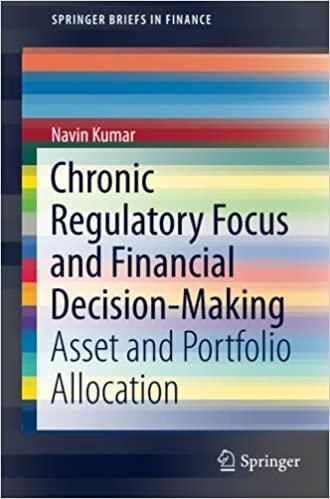(b) Now let's consider what happens to a network of four banks, as illustrated in Figure 1. The arrows represent exposures (holding other's securities). For instance, bank 2 is exposed to bank 1 (there is an arrow from bank 2 to bank 1), and that means bank 2's assets contain securities (debt or equity) issued by bank 1 . Figure 1: Network of banks. Suppose every bank's balance sheet is of the following form: "For instance, there is a 5% chance that the asset value will be $7 million next period. 4 Debt value rarely changes unless new debt is issued or old debt is paid back. That is, 80% of bank 2 's assets are securities issued by bank 1 , and the remaining 20% are loans made to other firms (non-banks). This immediately implies that the health of bank 1 impacts bank 2 . If bank 1 goes bankrupt, the securities (debt or equity) issued by bank 1 may go down in value, which will lead bank 2 to also suffer a loss in its assets, which may thn trigger bank 2 to go bankrupt as well. Recall how investors are paid in bankraptcy: 5 if a bank goes bankrupt, then its equity becomes worthless, and its debt holders get all remaining asset value with a possible "haircut". For instance, suppose a bank has leverage L=10 (so equity is 1/L=1/10=10% of total assets). Suppose the bank's asset value declines by 30%, so it goes bankrupt, its equity becomes worthless, and its debt is now worth 901308=97 as much as before 6 So the holders of the bank's equity sulfer a loss of 100% (all lost!), and the holders of its debt suffer a proportional loss of 197=9222.2%. Suggestion: for all questions below, you don't need to think in dollar values, but only noed to think about values in proportional terms - eg. loans are 20% of total asset value, in the balance sheet above. Now that we are done describing background information, let's go into the questions. In all questions below, your goal is to figure out what happens after (only) bank 1 sulfers a negative shock: the value of bank 1's "loans to other firms" suddenly becomes zero. (The "bank-issued securities" on bank 1 balance sheet is not affectod, and the "loans to other firms" held by other banks are also not affected.) Please answer the questions below. i. ( 1 point) llow high can the leverage ratio L be so that bank 1 will not go bankrupt in response to this negative shock? ii. ( 2 points) Now suppose banks hold debt speurities issued by other banks, 7 Suppose all banks have a leverage ratio of L=15. How many banks will go (b) Now let's consider what happens to a network of four banks, as illustrated in Figure 1. The arrows represent exposures (holding other's securities). For instance, bank 2 is exposed to bank 1 (there is an arrow from bank 2 to bank 1), and that means bank 2's assets contain securities (debt or equity) issued by bank 1 . Figure 1: Network of banks. Suppose every bank's balance sheet is of the following form: "For instance, there is a 5% chance that the asset value will be $7 million next period. 4 Debt value rarely changes unless new debt is issued or old debt is paid back. That is, 80% of bank 2 's assets are securities issued by bank 1 , and the remaining 20% are loans made to other firms (non-banks). This immediately implies that the health of bank 1 impacts bank 2 . If bank 1 goes bankrupt, the securities (debt or equity) issued by bank 1 may go down in value, which will lead bank 2 to also suffer a loss in its assets, which may thn trigger bank 2 to go bankrupt as well. Recall how investors are paid in bankraptcy: 5 if a bank goes bankrupt, then its equity becomes worthless, and its debt holders get all remaining asset value with a possible "haircut". For instance, suppose a bank has leverage L=10 (so equity is 1/L=1/10=10% of total assets). Suppose the bank's asset value declines by 30%, so it goes bankrupt, its equity becomes worthless, and its debt is now worth 901308=97 as much as before 6 So the holders of the bank's equity sulfer a loss of 100% (all lost!), and the holders of its debt suffer a proportional loss of 197=9222.2%. Suggestion: for all questions below, you don't need to think in dollar values, but only noed to think about values in proportional terms - eg. loans are 20% of total asset value, in the balance sheet above. Now that we are done describing background information, let's go into the questions. In all questions below, your goal is to figure out what happens after (only) bank 1 sulfers a negative shock: the value of bank 1's "loans to other firms" suddenly becomes zero. (The "bank-issued securities" on bank 1 balance sheet is not affectod, and the "loans to other firms" held by other banks are also not affected.) Please answer the questions below. i. ( 1 point) llow high can the leverage ratio L be so that bank 1 will not go bankrupt in response to this negative shock? ii. ( 2 points) Now suppose banks hold debt speurities issued by other banks, 7 Suppose all banks have a leverage ratio of L=15. How many banks will go








